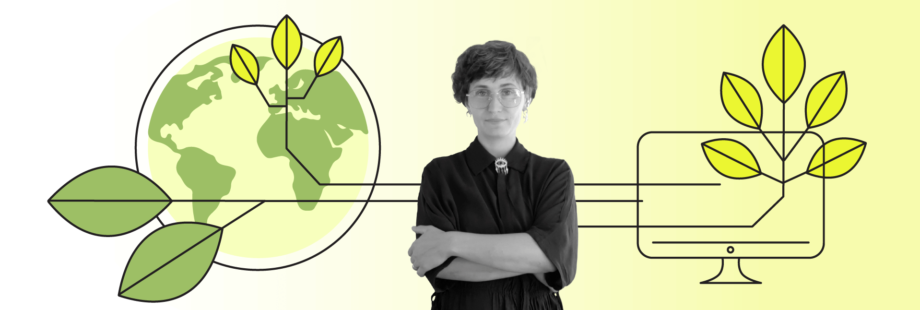
All you need to know about Green UX
Alicja MasiukiewiczReading Time: 11 minutes
We can slowly observe a shift from a carbon-based to more environmentally friendly power sources. But it’s a long process. It’s uneven across the world yet it affects the entire planet. Therefore our duty as a society is to be responsible and educated to push against global climate change. In this article, we’re going to discuss Green UX as a part of the solution. Its meaning and potential, as UX is the base for all online interactions.
What’s the problem?
I would say there are two main issues. One is the carbon footprint and water wastage we leave with every click. The second is that we teach our users to be unsustainable.
Ecological damages
Bernard Marr in his article for Forbes in 2018 says that 25*106 TB of data were created each day that year. I can only imagine how it looks like four years later and during the quarantine! According to greentheweb.com, a single web page consumes on average 1,76 g CO2 per page view. Datacenter energy consumption for 2020 was estimated to be 140 TWh in the USA only! It’s equal to the energy produced by 50 coal-fired 500-MW power plants and gives around $13 billions per year in electricity costs. It’s equal to 500 000 average British flats electricity usage per year!
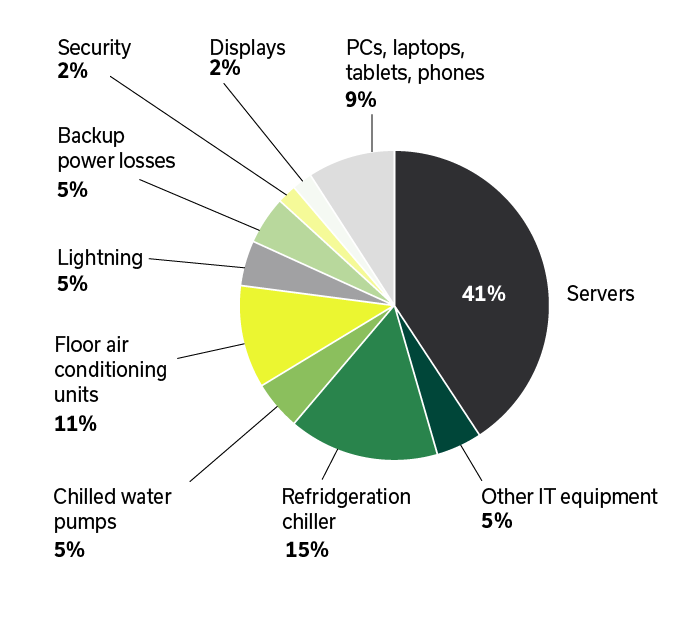
Information source: Energy-Efficient Management of Reconfigurable Computers Rathijit Sen, 5/13/2016 UNIVERSITY OF WISCONSIN-MADISON
According to the International Energy Agency, data centers consume approximately 200 terawatt-hours (TWh) per year of electricity. Or nearly 1% of global electricity demand, contributing to 0,3% of all global CO2 emissions.
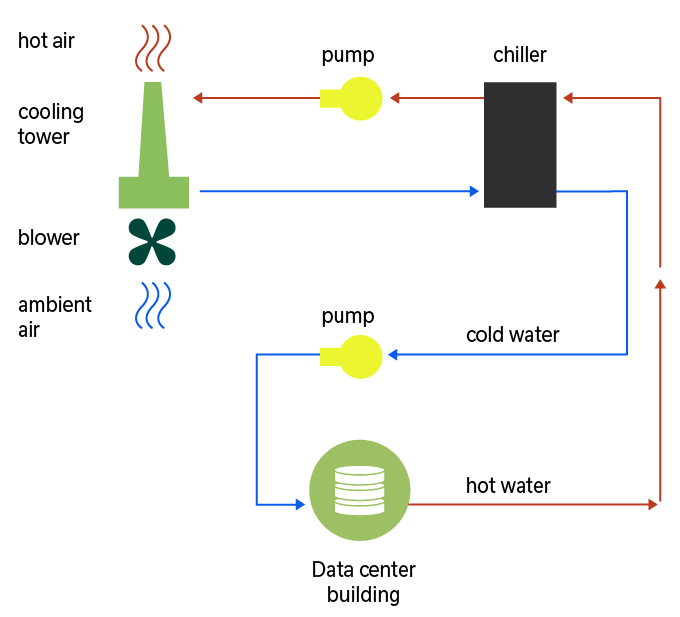
But it’s not everything. From around 30 to even 50% of the energy used by Data Centres goes to cooling. A process that involves insane amounts of water. A good example is a proprietary trade secret of Google. It leaked out during legal battles with local utilities and conservation. In 2019 alone, Google requested, or was granted, over 87 billion hectoliters of water for data centers in three different states. The trade secret forbade even public officials from disclosing the details. But we know that Google has 29 data center locations all over the world currently…
Information source: kinsta.com
The demand for the energy in IT is growing and it’s hard to imagine that it can stop. We’re getting more entangled in digital codependency. Is it bad? No. But it’s definitely not sustainable.
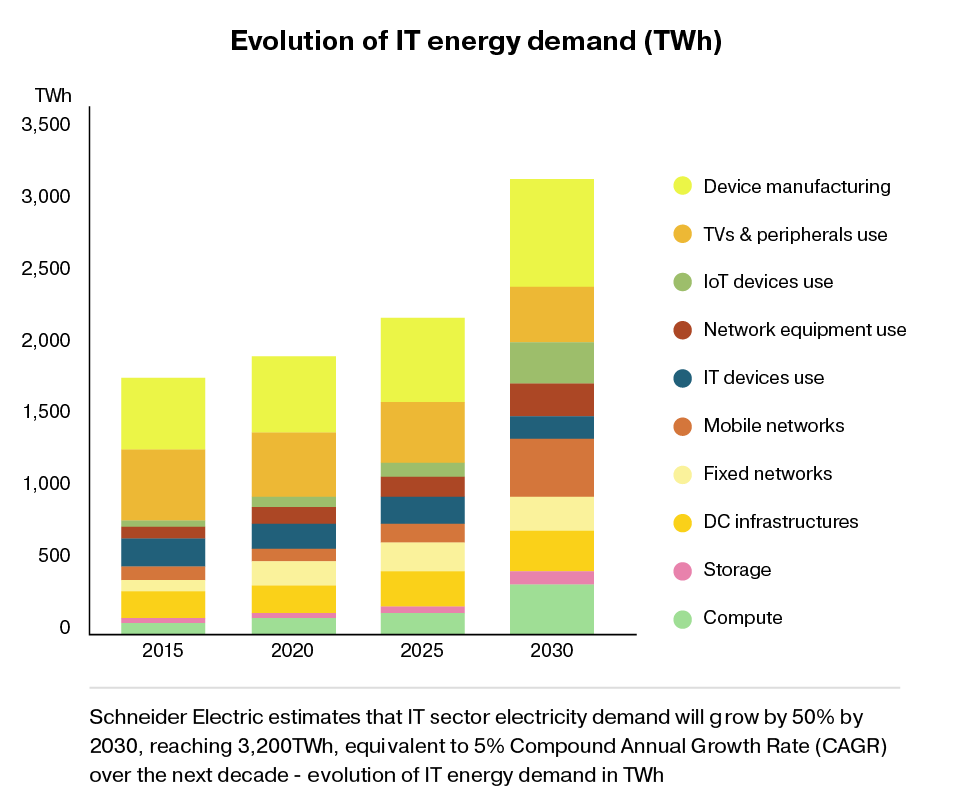
Bad habits
The second issue is the habits and standards we’ve developed.
We tend to hoard digital things. Pinterest boards full of inspirational images, newsletters that we don’t read, old junk mail, to-do lists, online accounts on the portals we never use, documents, drafts, photos… it all sits there without ever being used or revised, yet still eating energy.
Streaming is another thing. Especially now, many people spend time during quarantine or lockdown in front of the screen. We watch VODs or Youtube all day long. The autoplay option is good if used consciously. Otherwise, it’s another contribution to mindless CO2 production.
eCommerce is another variable in the equation that generates bad habits in users. Huge e-stores with intricate designs full of videos and photos. Dark patterns and a vicious cycle of consumerism. But it’s hard to find a balance. Everything we achieved digitally is precious. Now we just have to make it sustainable.
Green UX – what is it?
In simple words, Green UX is a UX that focuses on the ecological sustainability of the product. But there’s more. User Experience is a foundation of the product which means there is a great responsibility and huge possibilities. An environmentally conscious team can set the goals right and keep the project aligned to them. The end goal is to serve and educate customers and improve business.
But being ecologically aware and sustainable is a wider problem. It’s a matter of our future so it should be pretty straight forward yet it’s not. It becomes a political issue, it’s a part of a certain lifestyle, sometimes fashion. It also has a humongous economical impact as it requires shifts in many branches of the business.
Being aware of the problem, designers created an updated version of the F1st thing F1st Manifesto from 1964. It’s focused on environmental matters. It’s signed by thousands of designers and translated into 21 languages. This engagement proves how burning the issue is and that the creative community is also very aware of it.
What We Must Do
- We must challenge and examine the histories, processes, and ethics of design and develop new creative skills, resources, collaborations, and languages of design.
- We must support community-based efforts to advance and promote justice, healing, co-existence, and mutual respect.
- We must understand that we are not outside of nature; we are a part of a complex system and our actions must reflect that knowledge.
- We must reverse our profession’s priorities in favor of more inclusive, empathetic, and engaged forms of action — a mind-shift that goes beyond sustainability — towards regeneration, exploration, and co-creation of a non-exploitative, non-appropriative set of social-environmental relations.
- We must commit to reconnecting design, manufacturing, distribution, and use of the things we design to the Earth — and all of its inhabitants.
- We must direct our skills for the betterment of humanity towards a more ecological civilization.
We believe all of these principles should be integrated into multidisciplinary design education.
What should we do? Green UX in action
Technicalities in Green UX
If you don’t know where to start, first check your website: websitecarbon.com is a free tool to measure the carbon footprint of your website. You will get not only information about the amount of CO2 produced but also resources to make a change.
Hosting
Let’s start from the basics. The first conscious decision is to choose the hosting service wisely. It would be best to keep it locally. So check your area for good solutions. Let me share some examples:
British Provider - EcoHosting, uses typical British weather conditions for the cooling process. It means most days of the year (and pretty much every night) the chillers are doing very little. But there’s more to their mission, you can learn more about it on their website.
US, Canada, and the Netherlands can use GreenGeeks - awarded hosting service that offers an energy offset scheme. They purchase Renewable Energy Certificates three times their estimated consumption and plant a tree for every account they provision on their platform.
A carbon offset scheme is a way of balancing the carbon emission by canceling the impact caused by a company or individuals. It can be done by investing in reducing or storing carbon. For example by forest preservations, planting trees, or in renewable energy like solar power, wind farms, etc.
If you’re interested in more examples, there is a ranking provided by techradar.com.
Green UX: efficient solutions
The lighter and simpler the solution, the better it is for the environment. As a rule of thumb, avoid, or at least minimize, the use of complicated JavaScripts or heavy multimedia. But it’s also worth switching a custom font for system one and dropping a structure that requires many redirects and requests.
A fabulous example of a lightweight eco-conscious website is Organic Basic. For example, they replace photos with simple illustrations of the products. The photo is available on request in some cases, in others it’s not. Is it the right way to run the eCommerce store? I will leave the decision to you. But it’s definitely an amazing statement and proof that it’s possible.
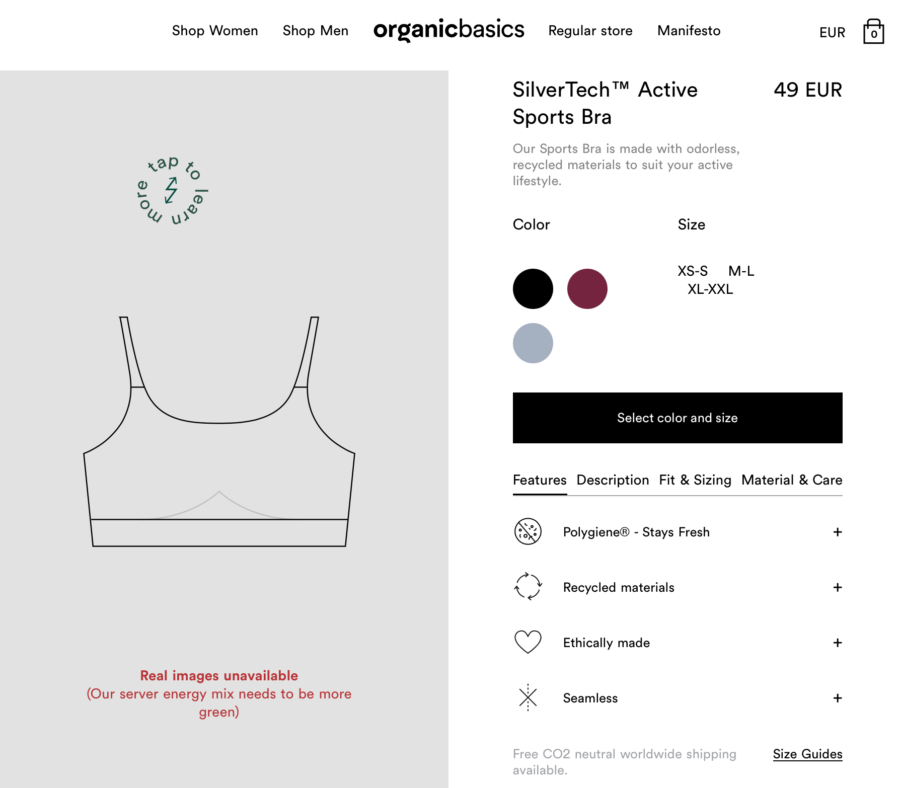
Source: Organic Basics.
File optimization
Not everyone will be able to use such an extreme approach. But still, we can make small steps toward a green and sustainable goal. If you have videos – don’t use the autoplay option.
If you use pictures – optimize them. With one action you will reduce loading times and decrease your website’s carbon footprint.
Use CSS sprites. With a single image holding all your icons, logos, and other elements repeatedly used on your website you can minimize HTTP requests and loading time.
Use proper file formats. JPEG is good for the bitmaps. They can be exported in different sizes and qualities. As you can see below depending on the size, the difference in quality can be invisible. A good practice is to always go for the smallest file possible without corrupting the design.
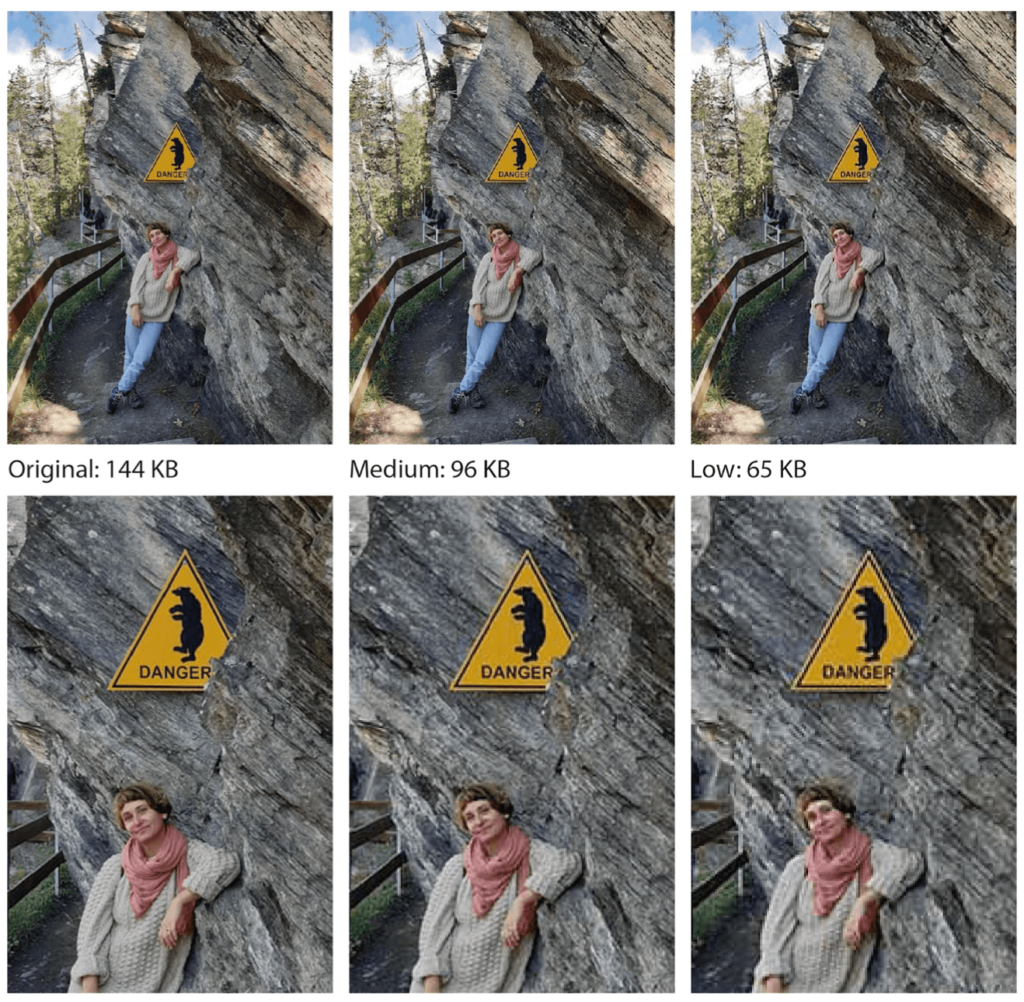
On the other hand, if you have a vector or simple line art illustration choose GIF or SVG format. For images that require transparency, PNG format is a good choice. Also take into consideration WebP format. It’s smaller than JPEG yet it offers higher quality, transparency and ability to animate.
What’s also important but easy to forget – don’t use images in your e-mail footer or your newsletter. Actually, plain text e-mails are not only light but also very engaging. They are always displayed the same. They load super fast and there is no problem with a feature that automatically turns off pictures in most of the recipients’ smart mailboxes.

Branding vs. Green UX
That is to say, are we still talking about the Green UX? Yes. The UX doesn’t end on the screen. If you think of sustainable changes in your or your client’s company, think about everything around.
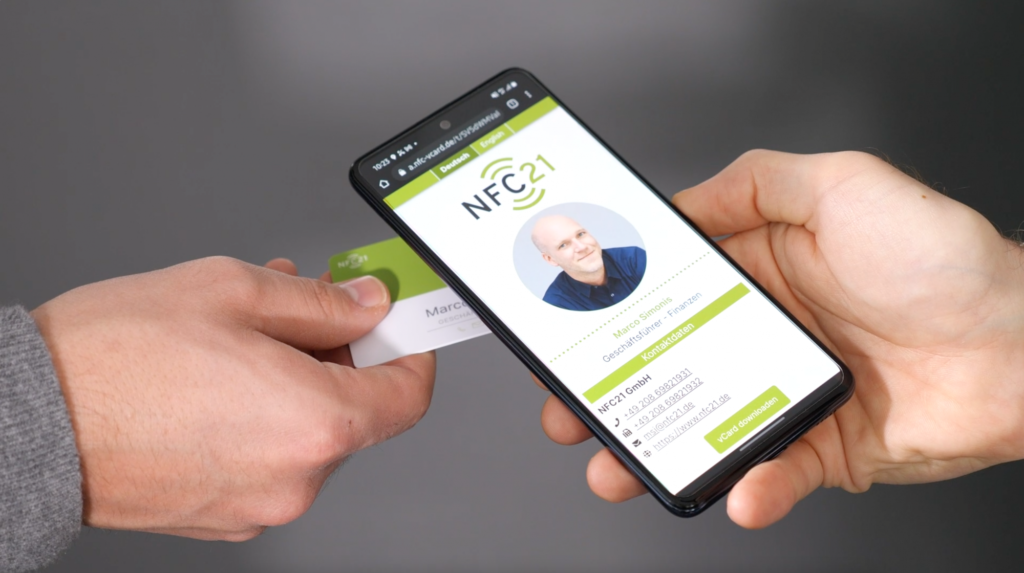
For example, do you still use business cards? Meanwhile, you can use NFC or QR code instead. NFC-TAG-SHOP offers wide variety of NFC products from cards, to tags and printed goods. If you prefer paper, go for the recycled. Same with all materials you share. Remember not all paints and dyes are environmentally friendly. Take a look at TOPQ – a nice example of an eco printing house.
NFC technology offers many opportunities to make your business and your products more digital, more resource-efficient and thus more sustainable - for example, for trade fair presentations, inventories or advertising and marketing measures. With the help of NFC, we create smart products that bring simplicity and digitalisation - including individually designed NFC articles and NFC-based software solutions. Because with NFC, you can retrieve a lot of information quickly and easily by scanning and thus use the technology in many areas of your own company. A very simple example is the business card: an individual link to your personal profile is stored on the NFC-vCard. Because it can be scanned as often as you like, each NFC-vCard replaces a classic business card many times over, depending on the form and material chosen. As a result, it protects the environment and production costs. It is therefore not only simple and convenient, but also efficient and thus sustainable.
Green UX in digital office management
What about your internal files and documents? Where do you store them? According to Brainwave.ai, the greenest cloud is offered by Google. However, do you remember the beginning of my article? I mentioned the amount of water used by Google Data Centers. That is to say we still have a long way to go. But at least Google puts an effort and you can see that in their reports.
Anyways, there are some improvements we all can make:
- If it’s not necessary to keep your files in the cloud, keep them on an external hard drive,
- If you have to use the cloud, remember to keep it clean. Your email draft from 2007 and shopping list from 2019 keep producing carbon footprint every day.
Moreover, you can step up your game even more. Firstly switch to the Ecosia search engine. The idea behind it is to use money from every search to plant trees in the areas that need it the most.
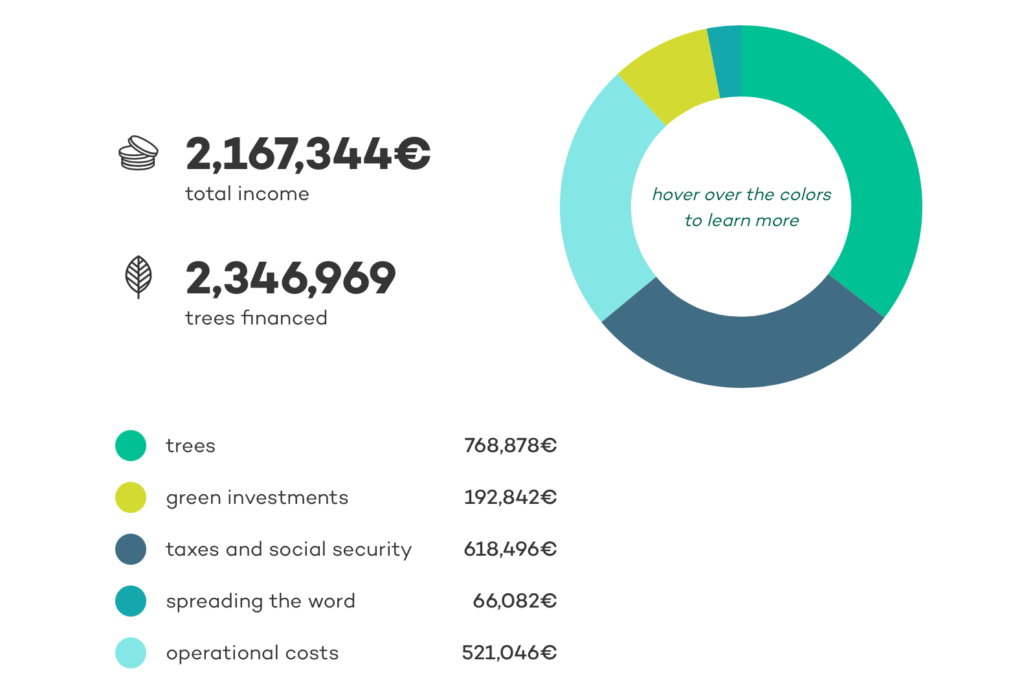
Source: Ecosia
And last but not least, both at work and in your private life. You subscribe to many websites and services for different reasons. In most cases it comes with a newsletter. There are ways to clean this mess as well.
First is, certainly, the easiest but can be time-consuming. In most mailboxes you will find a built-in unsubscribe button.
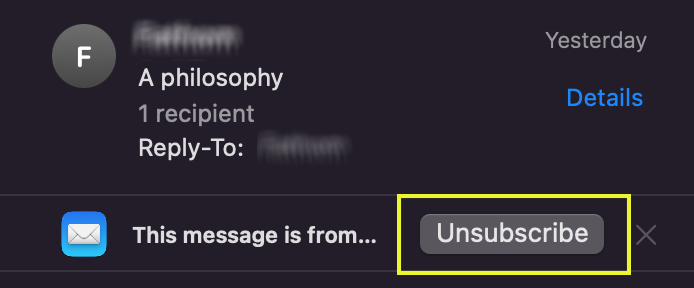
Or you can use some of the tools offered in the market. Like Leave Me Alone. It’s a pretty easy and effective tool. Depending on your need you can just try it with 5 unsubscriptions. Use one-off payment to clean up your mailbox or get a subscription if it’s a recurring problem for you.
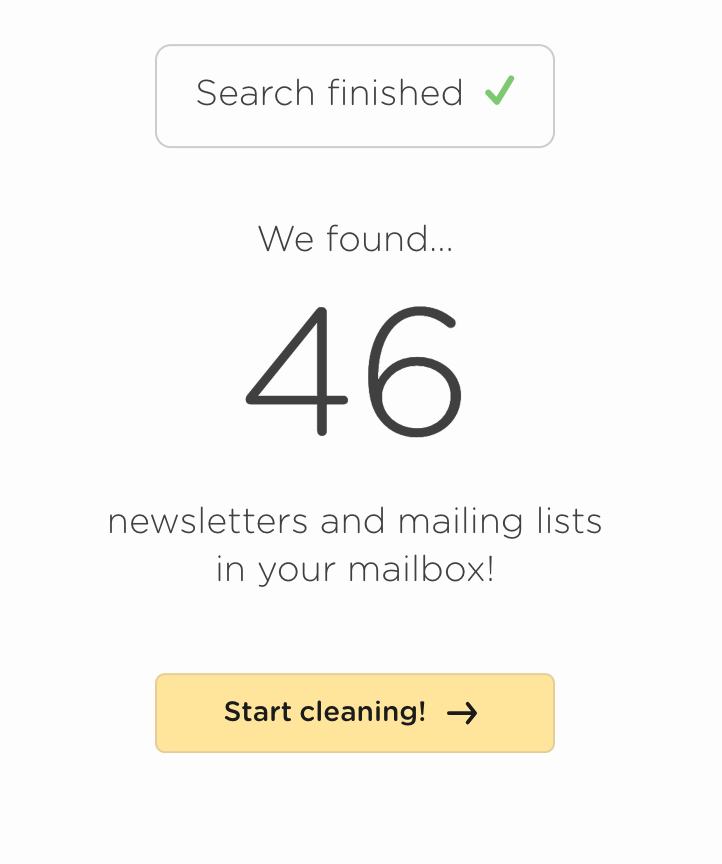
Current situation and sustainability issues
Business challenges related to Green UX
In business language, there are some keywords. Engagement, performance, security, conversion but sustainability is rarely one of them. As UX designers, we understand we need to educate our clients very often. Luckily clients “who know better” are in retreat. Although UX is a fancy term, spending money on it seems to be less fun for the decision-makers.
However Green UX may speak their language better than you know. For example, a sustainable website keeps a minimal amount of data. Therefore the loading time is minimal, the website is super fast, users are happy, there are fewer problems and there are better rankings in search engines. In short, the technical side the green approach has a lot to offer.
The second reinforcement comes with the statistics and customer behaviors. In 2021 Deloitte surveyed consumers regarding their attitudes to environmental and ethical sustainability.
Even though there are COVID-19 issues, the drive to become more sustainable is still on. The one third part of the respondents claims that sustainability and ethics are keys in their decision-making processes. 61% of consumers have reduced their usage of single-use plastics. 45% decided to buy locally grown produce. Amazingly almost 30% of consumers decided to stop purchasing brands or products if they had ethical or sustainability-related concerns about them.
World Economic Forum says there is a rise in online searches for sustainable goods over the past five years:
- 71% globally,
- 24% in Indonesia,
- a phenomenal rise of 120% in Ecuador.
Let me quote one staggering paragraph:
At a macro-economic level, nature-positive transitions for the food, infrastructure, and extractives sectors could generate over $10 trillion in annual business value to 2030 and create 395 million jobs. And the World Economic Forum’s analysis puts nature’s value to the global economy at $44 trillion – more than half of global GDP.
Less and less business owners should struggle to make eco-conscious decisions. However it’s not always easy to look at the big picture. The key in convincing CEOs and product owners to the Green UX is as simple as statistics and raising sustainable trends.
Dark patterns and greenwashing
Like everything, green trends have their ugly side. It’s called greenwashing. It takes place when a company spends more money on marketing sustainability, than actually minimizing their environmental impact.
According to McKinsey Report Gen Z, the new “consumer force”. They are more likely to spend money on products, services, and brands perceived as sustainable. One of many examples of greenwashing we all can stomp on is the scandal with Volkswagen. Long story short, many VW cars were sold with “defeat device/software” in diesel engines. The device could recognize when the carbon dioxide emission was tested. It changes the performance to give false emission results. The German car giant has since admitted to cheating emissions tests in the US. But the cars promoted as low-emissions and eco-friendly were already sold. I encourage you to read more about this scandal.
The same happens in other businesses. Nestlé with its horrible story of preying on developing countries, baby milk scandal, selling poisonous dog food, misleading marketing, and many more, also tries to show itself as eco-conscious. The food and beverage giant was held accountable by (among others) Greenpeace.
Green UX can help fight off greenwashing by making businesses more transparent. A great example is Nago - a store that gives you all information. Many brands follow this way to explain why fair products cost more.
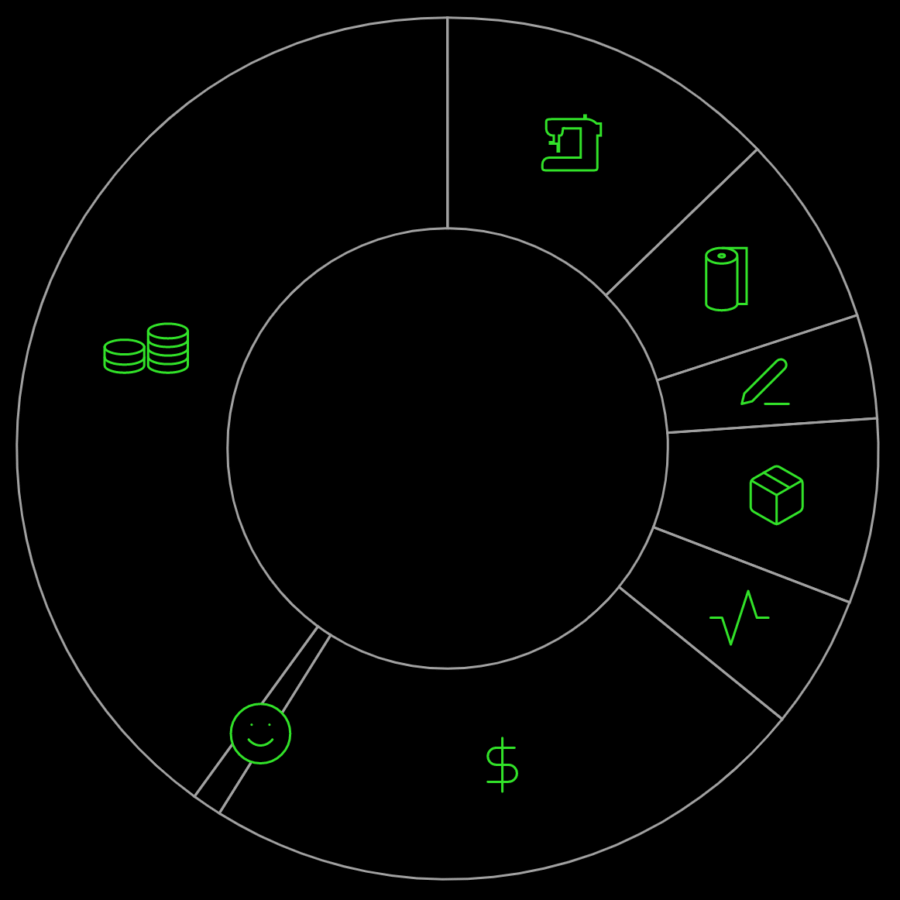
Source: Nago - see the detailed description of the chart elements in the link
Green UX solutions
There is so much to improve, we can start right away with small steps. We must remember that being green or sustainable is not only a buzzword. It’s a necessity and Green UX focused on environmental sustainability. Is just a part of dependencies and interconnected issues we struggle with.
So here are some things we can do:
Promote diversity and inclusiveness
Doesn’t sound like an eco-concern but it is. It’s important to remember our actions have an impact on the environment and people on the other side of the planet. By including images, mentions, and stories from other social and ethnic groups, we are less likely to close up in the information bubble. We may buy clothes in the EU but the servers can be located in the UK and products can be manufactured in China. We can’t forget we live in a huge global village and each action comes with consequences.
Inform and educate
If you give it a chance, most users will go for the green solutions. But, they need to be aware there is an option. eCommerce stands for the customer first approach, but usually, it’s only about the comfort of using. For example, a customer can choose between delivery door to door and the pick-up point. Small information about the difference in carbon footprint in those two can make a huge difference in customers behavior.
Back in 2016, Artiom Dashinsky wrote a great article titled “Product Design for Sustainability”. He was thinking of how to improve certain services and products, to make them more sustainable. It’s a pleasure to read this article now, after he updated it in 2021. Many of his ideas turned into reality. For example, he made a great point that food delivery always comes with plastic cutlery. Usually, it’s not needed as we all have it at home or in the office. So it would be best to have it on request. The good news is that by 2021 Uber Eats already introduced such an option and many others came along.
Referring back to the Deloitte survey. Customers asked why they haven’t adopted a sustainable lifestyle, three answers were prominent:
- I am not interested (22%),
- It was too expensive (16%),
- I don't have enough information (15%).

Taking financial issues aside, the other two reasons are for us, designers, a subject of change.
By introducing ideas like Artiom Dashinsky’s, we can teach consumers that sustainability is also about the budget. For example, when buying a more durable product, they will save money in the long run and make more green choices as a “side effect”.
By informing customers which option is more environmentally friendly we give them a chance to learn without effort. Above all, we make people get used to thinking of that issue on a daily basis.
Summary
As you could see there is a long way ahead. But we’re on the right track. In short,being eco-conscious becomes a standard and hopefully, soon articles like this one could be archived.
I would like to finish this article with a reminder, we all are responsible. The internet took off borders, now our actions can have an impact on people, animals or the environment on the other continent. As designers, we should remember about it and force sustainable solutions.
Green UX is not yet as standardized as “best practices for eCommerce” etc. however there are many resources. I tried to share as many as possible with you in this article in hope that you will find something suitable for your situation and abilities. Above all a small action is better than no action! So if it means by now you can only clean up your cloud, do it! It’s worth it!
Thank you for reading! I hope you will share some other ideas in the comments! If you would like to build a Green Project with us, contact us!




